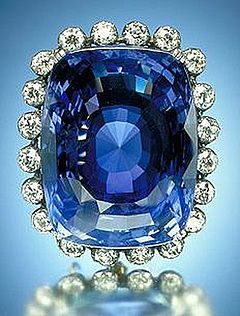Sapphire
| Sapphire | |
|---|---|

The 423-carat (85 g) blue Logan Sapphire
|
|
| General | |
| Category | Oxide mineral |
|
Formula (repeating unit) |
Aluminium oxide, Al2O3 |
| Crystal system | Trigonal |
| Crystal class | Hexagonal scalenohedral (3m) H-M symbol: (32/m) |
| Space group | R3c |
| Identification | |
| Color | Typically blue, but varies |
| Crystal habit | As crystals, massive and granular |
| Fracture | Conchoidal, splintery |
| Mohs scale hardness | 9.0 |
| Luster | Vitreous |
| Specific gravity | 3.95–4.03 |
| Optical properties | Abbe number 72.2 |
| Refractive index | nω=1.768–1.772 nε=1.760–1.763, Birefringence 0.008 |
| Pleochroism | Strong |
| Melting point | 2,030–2,050 °C |
| Fusibility | Infusible |
| Solubility | Insoluble |
| Other characteristics |
Coefficient of thermal expansion (5.0–6.6)×10−6/K ε = 8.9–11.1 (anisotropic) |
Coefficient of thermal expansion (5.0–6.6)×10−6/K
Sapphire is a gemstone variety of the mineral corundum, an aluminium oxide (α-Al2O3). It is typically blue in color, but natural "fancy" sapphires also occur in yellow, purple, orange, and green colors; "parti sapphires" show two or more colors. The only color which sapphire cannot be is red - as red colored corundum is called ruby, another corundum variety. This variety in color is due to trace amounts of elements such as iron, titanium, chromium, copper, or magnesium.
Commonly, natural sapphires are cut and polished into gemstones and worn in jewelry. They also may be created synthetically in laboratories for industrial or decorative purposes in large crystal boules. Because of the remarkable hardness of sapphires – 9 on the Mohs scale (the third hardest mineral, after diamond at 10 and moissanite at 9.5) – sapphires are also used in some non-ornamental applications, such infrared optical components; high-durability windows; wristwatch crystals and movement bearings; and very thin electronic wafers, which are used as the insulating substrates of very special-purpose solid-state electronics (especially integrated circuits and GaN-based LEDs).
...
Wikipedia
